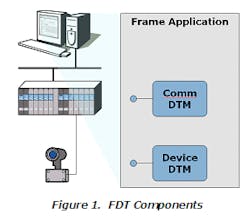The Components of FDT Technology: A Basic Introduction to DTMs and the FDT Frame
The advantages of deploying a technology like FDT that supports supplier independence, protocol independence, and host independence to maximize your investments in intelligent field measurement and control devices have been well documented. This makes good sense to most engineers and plant managers, but they naturally gravitate to the next question – how does it work? For starters, what are the basic components of the FDT technology?
We’ll start at the “bottom.” Devices that support FDT Technology are supplied with software known as a Device DTM. A Device DTM can be specific to a device or a family of devices and to the protocol (HART, FOUNDATION fieldbus, Profibus, etc.) that the device uses for communication to control systems, configuration tools, and other asset management applications. In essence, the Device DTM is a software program that contains the user interface and any diagnostics and processing functions the device manufacturer chooses to provide. Although its appearance and functionality are engineered by the device vendor they conform to the FDT Style Guide to provide a common structure across all manufacturers. Device DTMs have been described as analogous to “printer drivers” in the office world, since they look the same in any PC or application they run in.
As Figure 1 suggests, the Device DTM, when rendered in the Frame Application (more on this later), requires a means to communicate to the device. This “middle” layer is accomplished by what is called a Communication DTM, or more simply, Comm DTM. The Comm DTM is provided by manufacturers of communication devices such as gateways, communication cards and linking devices that provide the physical connection between the device and the PC based Application.
The final component, at the “top,” is the Frame Application. It is somewhat analogous to a browser, but it can have some very powerful capabilities. A DTM is represented within the Frame Application as a graphical interface to allow the user to manage the device. A Frame Application typically renders one device at a time, with most supporting multiple windows, to allow the user to interact with several devices. The Frame Application hosts the Comm and Device DTMs to support management of all the smart devices within a facility. Although available stand-alone from some organizations, the Frame Application is more commonly provided within a larger automation system within various environments, such as configuration and engineering tools, operator interfaces or asset management tools. For example, a Frame Application may be provided as part of a configuration tool for a DCS. Many process control system vendors that provide Frame Applications have embedded the Communication DTM functionality into their system configuration and management tools. The communication complexities of the network infrastructure, DCS controller, I/O systems and even different protocols are hidden, allowing the user to focus on the smart device task at hand. With many vendors incorporating the Communication DTMs within their respective system management tools, FDT Technology is often used without the user being aware of the ‘name’ of the underlying technology, hidden to simplify deployment.
Engineers and managers have a natural affinity for understanding the components of the technologies they deploy. While it is helpful to understand how something works, it is clear that the basic components and concepts of the FDT Technology are quite simple. FDT Technology can truly simplify how you manage the diverse systems, protocols, and devices you deploy in your facility.
For more information on FDT Technology, Device DTMs, Communication DTMs or Frame Applications please visit www.fdtgroup.org or e-mail at [email protected].

